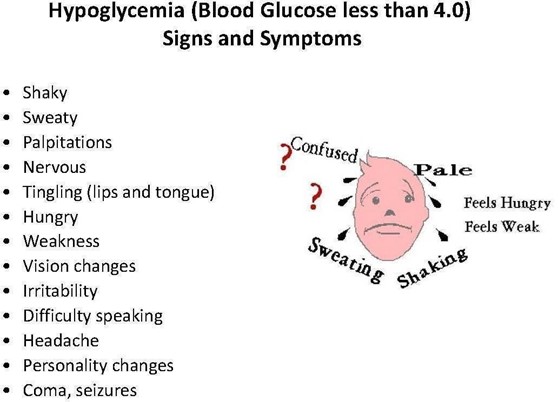The practical nurse (PN) is caring for a client newly diagnosed with diabetes mellitus (DM). Which finding is an early sign of hypoglycemia?
Polyuria.
Tremors.
Bradycardia.
Difficulty swallowing.
The Correct Answer is B
Hypoglycemia occurs when blood glucose levels drop below normal levels. It is commonly associated with diabetes mellitus and can result from various factors such as excessive insulin or oral hypoglycemic medication, delayed or missed meals, increased physical activity, or alcohol consumption.
Tremors, or shaking hands, are one of the early signs of hypoglycemia. They can occur due to the brain's response to low blood glucose levels. Other early signs of hypoglycemia may include sweating, palpitations, anxiety, hunger, and weakness.
A. Polyuria, or excessive urination, is not typically associated with hypoglycemia. It is more commonly seen in conditions such as hyperglycemia or diabetes insipidus.
C. Bradycardia, or a slow heart rate, is not a characteristic sign of hypoglycemia. It can occur in some cases of severe hypoglycemia, but it is not an early sign.
D. Difficulty swallowing is not directly related to hypoglycemia. It may be caused by other factors such as neurological or muscular conditions, esophageal disorders, or structural abnormalities in the throat or esophagus.

Nursing Test Bank
Naxlex Comprehensive Predictor Exams
Related Questions
Correct Answer is D
Explanation
Dry mucous membranes and a dry mouth are common side effects of anticholinergic drugs like dicyclomine. These medications block the action of acetylcholine, a neurotransmitter responsible for stimulating secretions in the body. As a result, the client may experience dryness in various parts of the body, including the mouth.
Providing oral care, such as offering the client sips of water or providing a moistening agent for the mouth, can help alleviate the discomfort caused by dryness and promote oral hygiene. It is an appropriate and immediate intervention for the client's current symptoms.
Incorrect:
A. Checking vital signs may not directly address the client's dry mouth, but it is a good practice to assess the client's overall condition.
B. Monitoring hemoglobin would not be necessary in this situation, as it does not directly relate to the client's dry mucous membranes.
C. Notifying the charge nurse may be appropriate if the client's symptoms worsen or if there are other concerning factors, but the priority action in this case is to provide oral care to address the client's discomfort.
Correct Answer is D
Explanation
Regular insulin is the medication of choice for treating DKA. Its main action is to lower blood glucose levels by promoting the uptake of glucose into cells and inhibiting the production of glucose by the liver. Therefore, checking the fingerstick blood glucose level is an important indicator of the effectiveness of the insulin treatment.
A decrease in the blood glucose level indicates that the insulin is working to lower the high blood sugar associated with DKA. This measurement helps the PN assess the response to treatment and adjust the insulin dosage if necessary.
The other actions mentioned are also important assessments in the care of a client with DKA, but they do not specifically evaluate the effectiveness of the insulin dosage:
A. Smelling the client's breath for resolution of a fruity odor is important as it indicates a decrease in ketone production, which is a marker of improving DKA. However, it does not directly evaluate the effectiveness of the insulin dosage.
B. Determining the client's orientation to time and space is part of assessing their neurological status, which is crucial in managing DKA. However, it does not specifically assess the effectiveness of the insulin dosage.
C. Measuring the client's urinary output for an increased volume is important to monitor hydration status and renal function, but it does not directly evaluate the effectiveness of the insulin dosage.
Whether you are a student looking to ace your exams or a practicing nurse seeking to enhance your expertise , our nursing education contents will empower you with the confidence and competence to make a difference in the lives of patients and become a respected leader in the healthcare field.
Visit Naxlex, invest in your future and unlock endless possibilities with our unparalleled nursing education contents today
Report Wrong Answer on the Current Question
Do you disagree with the answer? If yes, what is your expected answer? Explain.
Kindly be descriptive with the issue you are facing.
